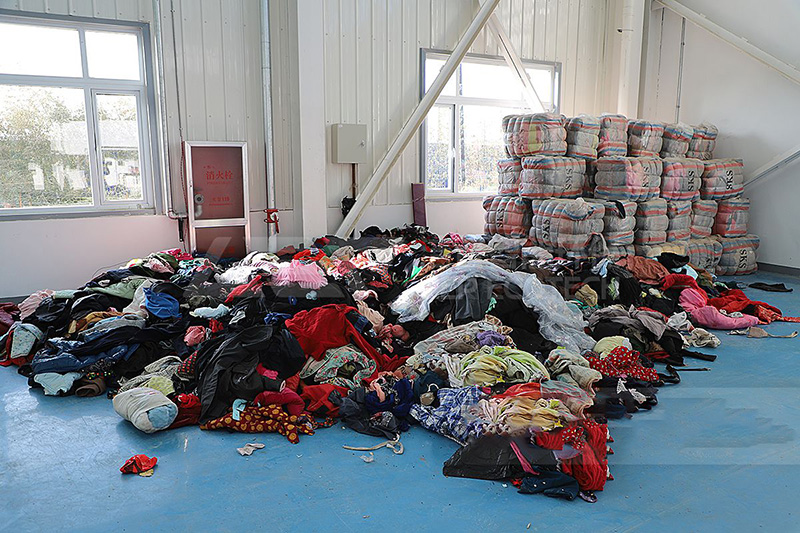
Tel/Whatsapp:+86 15649675999
Email:sale@kowloonmachine.com

Tel/Whatsapp:+86 15649675999
Email:sale@kowloonmachine.com
Article published:2023-09-26
Waste Textile Recycling
Our Country is the world's largest textile producer, consumer and exporter, and its total textile fiber processing accounts for more than 50% of the world's total. As per capita fiber consumption continues to increase, a large amount of waste textiles are produced.
In April 2022, the "Implementation Opinions on Accelerating the Recycling of Waste Textiles" jointly issued by the National Development and Reform Commission, the Ministry of Commerce, and the Ministry of Industry and Information Technology requires that by 2025, a waste textile recycling system will be initially established and recycling capabilities Significant improvement, the recycling rate of waste textiles has reached 25%, and the output of recycled fiber from waste textiles has reached 2 million tons. By 2030, a relatively complete waste textile recycling system will be established, the recycling awareness of producers and consumers will be significantly improved, high-value utilization channels will continue to expand, the level of industrial development will be significantly improved, the waste textile recycling rate will reach 30%, and the waste textile recycling rate will reach 30%. The output of recycled fiber reaches 3 million tons.

The current situation is that my country's annual waste textile production exceeds 22 million tons, but the recycling rate is only 20%. Data shows that if all waste textiles in my country are recycled, 12 million tons of chemical fibers and 6 million tons of natural fibers can be provided a year, which is equivalent to saving 24 million tons of crude oil and more than half of the output of Daqing Oilfield. It can be seen that increasing the recycling rate of waste textiles can not only effectively supplement the supply of raw materials for my country's textile industry, but also alleviate resource and environmental constraints. Faced with such a “rich mine” with huge potential for development, what should we do?
Waste textile recycling methods
At present, waste textiles are mainly recycled through the following methods:
Zero-stage recycling method: This is the simplest recycling method. After sorting, cleaning, repairing, disinfecting and other processing, the recycled waste textiles can continue to be circulated and used for their original purposes, flowing into rural or remote mountain villages, or exported to economically underdeveloped countries.
Primary recycling method: Textile production will produce waste materials, waste silk, and unused scraps. These waste materials are relatively clean. Mixing them with new materials to make new textile materials not only eliminates waste, but also saves costs, killing two birds with one stone. .
Physical recycling method: Without destroying the chemical composition and structure of the polymer, mechanical force is used to assist in crushing waste textiles, which are processed through classification, purification, drying, and adding relevant additives, and then reused in the production of new textiles.
Chemical recycling method: Use chemical reagents to degrade or decompose materials in waste textiles, repolymerize them into polymers, and use them to prepare regenerated fibers, or use small molecules of the degradation products for non-textile materials.
The zero-level recycling method and the primary recycling method are widely used because they are simple and easy to operate and have low technical content. However, waste textiles that do not meet the requirements of the law will be simply landfilled and simply incinerated, thus causing a waste of resources; in retrospect, physics The recycling method and chemical recycling method have not yet become popular due to high technical requirements and high cost.
A standout energy recovery method
In addition to the above methods, energy recovery methods are getting more and more attention and recognition from society. The so-called energy recovery method is to convert chemical fibers with high calorific value in waste textiles into heat through incineration, which can be used for thermal power generation and heating. This method is different from simple and crude burning. Incineration is low cost and easy to operate, but it seriously pollutes the atmospheric environment and hinders the achievement of the "double carbon" goal; the energy recovery rule is to recover energy from waste textiles in the form of fuel, thereby improving their recycling rate.
So how to convert waste textiles into fuel? Using Kowloon's waste textile alternative fuel preparation system is the perfect solution.
The system adopts the process of pre-crushing, magnetic separation, fine crushing and forming, which can effectively convert waste textiles into RDF alternative fuel with high calorific value. If the material composition is not so pure, we can also install air separators, metal detectors and other equipment to obtain clean RDF fuel through multiple sorting and filtration. The entire system is equipped with professional dust removal equipment, which can effectively handle the dust generated during operation without causing secondary pollution.
Common fabrics and vinyl coatings in textiles have a calorific value of 4200 to 4800 kcal, which is nearly 0.8 times that of thermal coal. The fuel made from 1.2 tons of waste textiles is equivalent to the heat energy provided by 1 ton of thermal coal. With the magic weapon of high calorific value, fuel made from waste textiles can be sold at a high price. If you are a fuel preparation manufacturer, congratulations, you can not only collect disposal fees from waste production companies, but also sell alternative fuels to coal-fired power plants and cement plants to make money, a win-win situation!